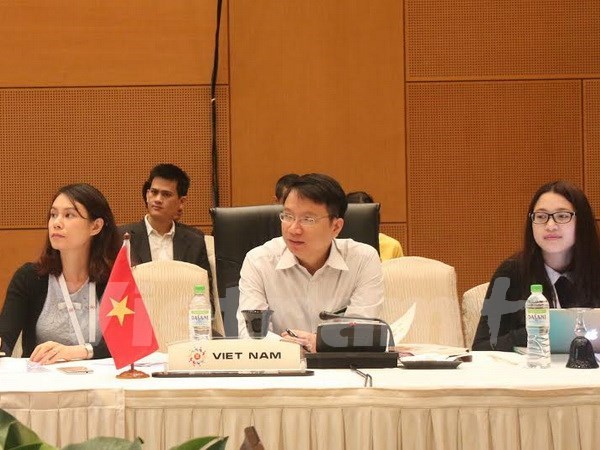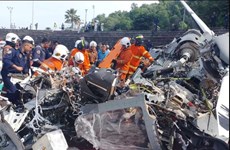One step nearer to ASEAN Economic Community
The 47th ASEAN Economic Ministers’ Meeting, taking place in Kuala Lumpur, Malaysia from August 22-25, will complete final preparations for the formation of the ASEAN Economic Community (AEC).
 The Vietnamese delegation at the meeting. Photo: VNA
The Vietnamese delegation at the meeting. Photo: VNAThe 47th ASEAN Economic Ministers’ Meeting, taking place in Kuala Lumpur, Malaysia from August 22-25, will complete final preparations for the formation of the ASEAN Economic Community (AEC) by the end of this year.
According to ASEAN Secretary General Le Luong Minh, more than 90 percent of 506 AEC measures have been implemented since the AEC blueprint was approved in 2008.
Malaysian Minister of International Trade and Industry Datuk Seri Mustapa Mohamed said the formation of the AEC will formally establish a single market among the 10 member states of ASEAN, creating a seamless trade and investment regime in ASEAN and helping raise the bloc’s total GDP to 4.7 trillion USD by 2020 from the current 2.7 trillion USD.
ASEAN has grown into a comprehensive regional cooperation organisation and a dynamic political-economic entity, holding an important position and role in the Asia-Pacific region. The grouping is entering a new development phase towards the establishment of a common community based on three pillars: the ASEAN Political-Security Community, the AEC and the Socio-Cultural Community, of which the AEC is the most important, creating the foundation upon which to develop the two remaining pillars.
The birth of the AEC is the follow-up of intra-bloc economic cooperation programmes to boost regional economic development through connecting the 10-member market with more than 630 million consumers and a combined GDP ranking seventh and workforce ranking third in the world.
Through the AEC, ASEAN expects to form a stable, prosperous and competitive economic area which encourages the free travel of goods, services and investments. Once it becomes a common economic entity, AEC will be the world’s seventh largest economy, potentially growing to the fourth largest in 2050.
Despite impacts from the economic recession, ASEAN countries have made many economic achievements and revised and issued policies to turn the region into an independent market with a free flow of goods, services, investments and skilled workers.
However, the bloc is facing several problems in the process, first of all the poor conditions of infrastructure and the impacts of trade barriers as well as non-tariff protection measures, which can seriously limit the growth of intra-bloc trade.
The second issue is the development gap among member countries. Less developed countries are worried about possible trade deficit with stronger economies, as more developed countries will benefit greater from heavy industry, chemicals, pharmaceuticals, financial-banking services and other services.
Thirdly, member countries still hold different viewpoints on joining free trade agreements outside the bloc, such as the Trans-Pacific Partnership (TPP) and the Regional Comprehensive Economic Partnership (RCEP).
It can be said that the realisation of the AEC is a long-term goal with 2015 being an important milestone. The formation of the AEC not only means ASEAN has become a common economic entity but also sends a strong signal on the need for drastic methods to build a free and integrated economic area.
For Vietnam, ASEAN is one of the important pillars in the country’s external relations policy. ASEAN is one of the most important trade partnership and a driving force that helped the Vietnamese economy maintain its growth rate and export over the past years.
According to the Ministry of Industry and Trade, as of March 31, Vietnam and Singapore led the group in completing AEC measures with 94.5 percent, reflecting Vietnam’s resolve and efforts to build the community by year’s end.
Specifically, Vietnam has reduced import tariffs on 9,265 tariff lines (97 precent) to 0-5 percent in line with the ASEAN Trade in Goods Agreement (ATIGA).
The country has been working closely with ASEAN countries to review and implement the ASEAN Trade Facilitation Work Programme for 2007-2015 with a focus on customs, trade procedures, standards and conformance, ASEAN one-stop-shop customs mechanisms and ASEAN trade facilitation databases.
Vietnam and six other ASEAN countries – Brunei, Indonesia, Malaysia, the Philippines, Singapore and Thailand – have implemented all or part of the one stop shop mechanism and are participating in deploying the ASEAN mechanism for some components.
For trade in services, Vietnam joined ASEAN countries to complete the 9th ASEAN Frame Agreement on Service (AFAS) Package while working on building the 10th AFAS Package. The country and ASEAN began negotiations on ASEAN trade in services to inherit and consolidate the AFAS agreement.
Vietnam, like other ASEAN members, has strengthened efforts to progress against investment restriction removal. In the field of investment promotion and liberalisation, Vietnam achieved results including publishing guidebooks for business investment and an annual ASEAN Investment Report, organising seminars and forums on investment promotion, developing ASEAN information sites on investment and more.
Vietnam is also actively cooperating with ASEAN countries in implementing activities in other areas, including strengthening competitiveness in food, agriculture and forestry among ASEAN; building strategic action plans on food security; embracing effective cooperation methods; adopting legal documents as the basis for cooperation in air and road transport; and implementing programmes and measures to support small and medium-sized enterprises.
Looking forward, Vietnam pledges to work with other ASEAN countries to ensure the ASEAN Community, especially the AEC, is formed on scheduled in order to promote the bloc’s role and position.-VNA













